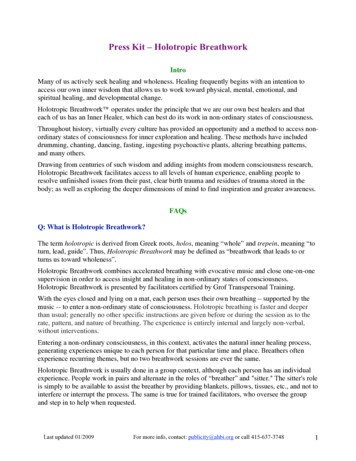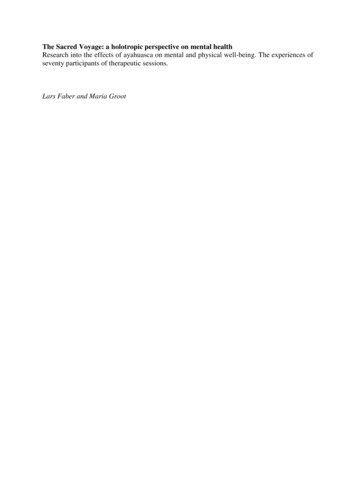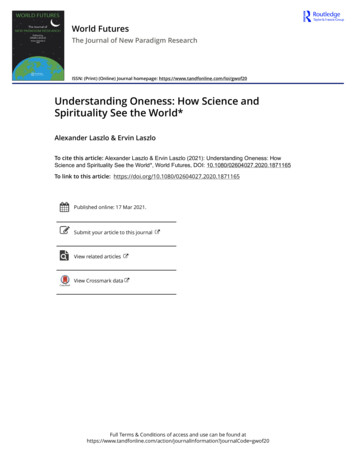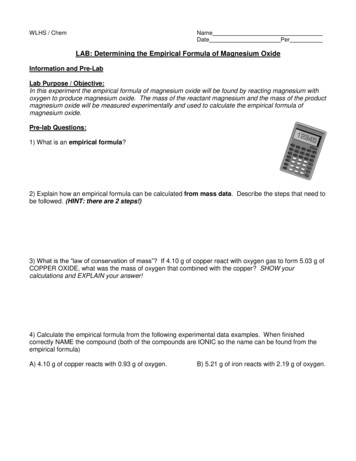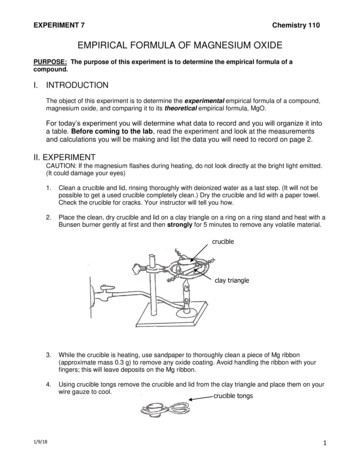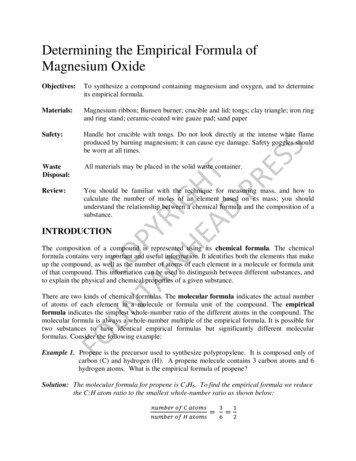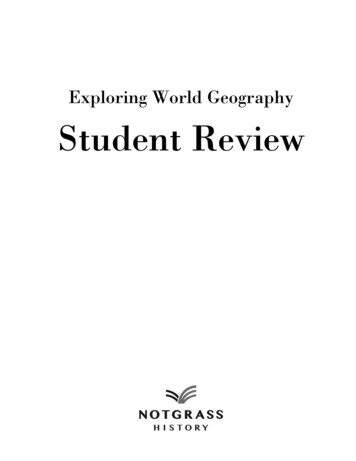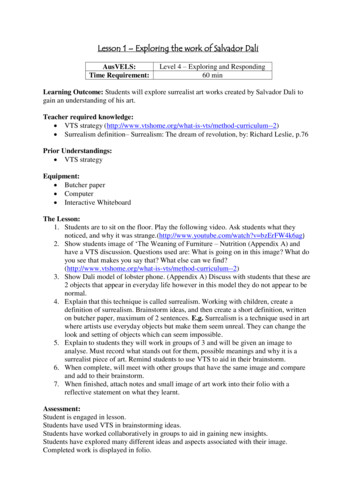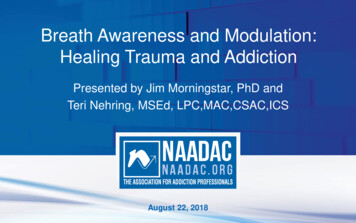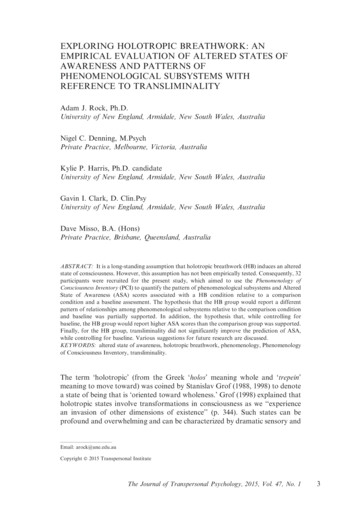
Transcription
EXPLORING HOLOTROPIC BREATHWORK: ANEMPIRICAL EVALUATION OF ALTERED STATES OFAWARENESS AND PATTERNS OFPHENOMENOLOGICAL SUBSYSTEMS WITHREFERENCE TO TRANSLIMINALITYAdam J. Rock, Ph.D.University of New England, Armidale, New South Wales, AustraliaNigel C. Denning, M.PsychPrivate Practice, Melbourne, Victoria, AustraliaKylie P. Harris, Ph.D. candidateUniversity of New England, Armidale, New South Wales, AustraliaGavin I. Clark, D. Clin.PsyUniversity of New England, Armidale, New South Wales, AustraliaDave Misso, B.A. (Hons)Private Practice, Brisbane, Queensland, AustraliaABSTRACT: It is a long-standing assumption that holotropic breathwork (HB) induces an alteredstate of consciousness. However, this assumption has not been empirically tested. Consequently, 32participants were recruited for the present study, which aimed to use the Phenomenology ofConsciousness Inventory (PCI) to quantify the pattern of phenomenological subsystems and AlteredState of Awareness (ASA) scores associated with a HB condition relative to a comparisoncondition and a baseline assessment. The hypothesis that the HB group would report a differentpattern of relationships among phenomenological subsystems relative to the comparison conditionand baseline was partially supported. In addition, the hypothesis that, while controlling forbaseline, the HB group would report higher ASA scores than the comparison group was supported.Finally, for the HB group, transliminality did not significantly improve the prediction of ASA,while controlling for baseline. Various suggestions for future research are discussed.KEYWORDS: altered state of awareness, holotropic breathwork, phenomenology, Phenomenologyof Consciousness Inventory, transliminality.The term ‘holotropic’ (from the Greek ‘holos’ meaning whole and ‘trepein’meaning to move toward) was coined by Stanislav Grof (1988, 1998) to denotea state of being that is ‘oriented toward wholeness.’ Grof (1998) explained thatholotropic states involve transformations in consciousness as we ‘‘experiencean invasion of other dimensions of existence’’ (p. 344). Such states can beprofound and overwhelming and can be characterized by dramatic sensory andEmail: arock@une.edu.auCopyright ’ 2015 Transpersonal InstituteThe Journal of Transpersonal Psychology, 2015, Vol. 47, No. 13
perceptual changes, intense and unusual emotions and behavior, alterations inthought patterns, and psychosomatic manifestations. However, Grof assertedthat such states are qualitatively different to pathological non-ordinary statesof consciousness, such as those relating to cerebral trauma, infections, ordegenerative and circulatory brain processes.Holotropic Breathwork (HB) is a technique that was developed by Grof and hiswife Christina in the 1970s (Grof & Grof, 2010). It is designed to facilitate nonordinary, or holotropic, states of consciousness without the use of pharmacologic means. Instead, it combines rapid, deep breathing, evocative music,focused bodywork, and artistic expression within a safe, supportive groupenvironment. According to Grof and Grof, non-ordinary states of consciousness facilitate an ‘inner radar’ that is able to detect emotionally charged materialand bring it into consciousness for processing and subsequent healing.HB has been studied in the context of addiction recovery (Brewerton, Eyerman,Cappetta, & Mithoefer, 2012; Jefferys, 1996; Metcalf, 1995; Taylor & Macy,2008), death anxiety and self-esteem (Holmes, Morris, Clance, & Putney, 1996),personality (Binarova, 2003), mood states and psychiatric symptomatology(Hanratty, 2002; Pressman, 1993), and respiratory (Terekhin, 1996) andneurophysiological (Spivak, Kropotov, Spivak, & Sevostyanov, 1994) activity.For example, Pressman (1993) conducted an experiment designed tocomparatively analyze the effects of HB and music therapy on mood states.While groups did not differ at baseline, the author reported statisticallysignificant post-test differences between the HB and the music therapy group onall sub-scales of the Profile of Mood States (McNair, Lorr, & Droppleman,1971). Rhinewine and Williams (2007) suggested that this result signifies ‘‘thata greater degree of altered consciousness was induced in the HB group’’ (p. 773).In another study, Holmes et al. (1996) comparatively analyzed HB andexperientially oriented therapy (EOT) regarding numerous outcome variables.The authors reported statistically significantly greater post-test reductions indeath anxiety (measured by Templer’s Death Anxiety Scale; Templer, 1970)and statistically significantly greater increases in self-esteem (measured by thePersonality Research Form E: Jackson, 1984) for the HB group compared tothe EOT group.In a subsequent unpublished HB study, Hanratty (2002) implemented a singlegroup, within-subjects, pre/post-test design. The author reported statisticallysignificant post-test reductions in negative affect and psychiatric symptoms asquantified by the Positive and Negative Affect Scale (Watson, Clark, &Tellegen, 1988) and the Brief Symptoms Inventory (Derogatis & Spencer, 1987),respectively.Underpinning the HB literature is the long-standing assumption that HBinduces a non-ordinary or altered state of consciousness (ASC) (e.g., Grof &Grof, 2010). For example, Rhinewine and Williams (2007) suggested, ‘‘HBwould appear to capitalize upon the effects of hyperventilation on the centralnervous system to facilitate development of a temporary, benign, and4The Journal of Transpersonal Psychology, 2015, Vol. 47, No. 1
potentially therapeutic state of altered consciousness’’ (p. 772). Similarly,Brewerton et al. (2012) stated, ‘‘HB offers the addict many opportunities thatmay enhance addiction treatment, including entering non-ordinary states ofconsciousness ’’ (p. 453).CONCEPTUALIZING (ALTERED) STATESOFCONSCIOUSNESSLudwig (1969) defined ASCs as ‘‘any mental state(s), induced by variousphysiological, psychological, or pharmacological manoeuvres or agents, whichcan be recognized subjectively’’ (p. 9). Ludwig also identified a variety ofgeneral characteristics exhibited by ASCs, e.g., hypersuggestibility, a sense ofineffability, and a loss of volitional control. Unfortunately, as Rock andKrippner (2007a, 2007b) pointed out, Ludwig’s (1969) definition neglects tooperationalize the notion of a ‘‘sufficient deviation in subjective experience’’(italics added; pp. 9-10). Furthermore, Ludwig did not identify the ‘‘generalnorms’’ related to ordinary waking states (Rock & Krippner, 2007a, 2007b).In contrast to Ludwig (1969), Krippner (1972) formulated a definition of ASCsthat eliminates the problems associated with operationalizing the qualifyingterm ‘‘sufficient.’’ Krippner (1972) defined an ASC as ‘‘a mental state which[that] can be subjectively recognized by an individual (or by an objectiveobserver of the individual) as representing a difference in psychologicalfunctioning from the individual’s ‘normal’ alert state’’ (p. 1).Similarly, Tart (1969) defined an ASC for a given individual as one in which heor she experiences aqualitative shift in his pattern of mental functioning, that is, he feels not justa quantitative shift (more or less alert, more or less visual imagery, sharperor duller, etc.), but also that some quality or qualities of his mental processesare different. (p. 1)(Examples of qualities may include alterations in space-time perception, visualhallucinations, and the dissolution of one’s ego.) One may contend that Tart’sdecision to include both quantitative and qualitative differences in cognitivefunctioning within the definitional boundaries of the acronym ASC, renders hisformulation of the concept superior to Krippner’s (1972) attempt atoperationalization.Subsequently, Fischer (1971, 1972, 1976) developed a perception-meditationcontinuum that allows one to distinguish between ergotropic and trophotropicarousal. These refer, respectively, to hyperaroused (ecstatic) states and the‘‘hypoaroused states of Zazen and Yoga samadhi’’ (Fischer, 1971, p. 897).It is noteworthy that Tart (1975) argued that the term ‘‘states of consciousness’’(and its variant, ‘‘altered states of consciousness’’) ‘‘have come to be used tooloosely, to mean whatever is on one’s mind at the moment’’ (p. 5).Consequently, Tart developed the term ‘‘discrete states of consciousness’’Phenomenology of Holotropic Breathwork5
(d-SoCs) in an attempt to rectify this terminological problem. A d-SoC refersto a ‘‘unique configuration or system of psychological structures orsubsystems that maintains its integrity or identity as a recognizable systemin spite of variations in input from the environment and in spite of various(small) changes in the subsystems’’ (Tart, 1975, p. 62). Pekala (1985) assertedthat, from Tart’s perspective, it is the pattern or configuration of these differentstructures or subsystems (i.e., phenomenological elements) that constitutes ad-SoC. In contrast, Singer (1977) suggested that it is the intensity of thesedifferent elements, rather than the pattern, that defines a d-SoC. Pekala andWenger (1983) synthesized the essential aspects of Tart’s and Singer’sconceptions to define a state of consciousness (SoC) as the ‘‘particularintensity and pattern of associated phenomenological parameters thatcharacterize one’s subjective experience during a given time’’ (pp. 252-253).We emphasize that to date, and to the best of our knowledge, the assumptionthat HB induces an ASC has not been verified empirically in the context ofa controlled evaluation. In the next section we will describe a quantitativephenomenological instrument derived in part from Tart (1975) and Singer(1977) that allows one to test the hypothesis that HB induces an ASC.THE PHENOMENOLOGYOFCONSCIOUSNESS INVENTORYHB experiences may be quantified using a methodology that was developed byPekala (1985) to ‘‘operationally define, map and diagram states and alteredstates of consciousness’’ (p. 207).1 This methodology consists, in part, ofa novel retrospective phenomenological assessment instrument referred to asthe Phenomenology of Consciousness Inventory (PCI) (Pekala, 1991). The PCI isa 53-item questionnaire consisting of 12 major dimensions or phenomenological (i.e., subjective) elements (e.g., Positive Effect, Altered Experience, VisualImagery, Altered State of Awareness, Rationality), and 14 minor dimensions(e.g., Fear, Joy, Altered Body Image, Absorption).The PCI allows one to define operationally or ‘map’ phenomena typicallyreferred to as d-SoCs or ASCs by producing ‘‘psygrams’’ (graphs) that providetwo types of information associated with exposure to a stimulus condition: (a)the average intensity values (ranging from 0–6) for each PCI major dimension,and (b) the strength of the association between pairs of PCI major dimensions(Pekala, & Kumar, 1986). One creates a psygram by first producinga correlation matrix consisting of the 12 PCI major dimensions. The nonsignificant correlation coefficients (p . .05)2 are ignored, whereas significantr values are converted to r2 values (i.e., coefficients of determination).Subsequently, the r2 values are converted to percentages. Each line linkinga pair of major dimensions constitutes 5% of the r2 or variance in common (i.e.,covariance) (Pekala, 1991). Thus, the higher the r2, the stronger the couplingbetween a given pair of major dimensions.3The performative function of a psygram is aligned with Tart’s (1975) notion ofa d-SoC. As previously stated, Pekala (1985) asserted that, in Tart’s view, it is the6The Journal of Transpersonal Psychology, 2015, Vol. 47, No. 1
pattern formed by these various psychological subsystems that comprises ad-SoC. Consequently, if the psygram associated with a baseline or comparisoncondition is statistically significantly different from a psygram associated with,for example, a HB condition, then one may conclude that the HB condition wasassociated with a ‘‘major reorganization in pattern structure that is hypothesizedby Tart (1975) to be associated with an altered state of consciousness’’(Woodside, Kumar, & Pekala, 1997, p. 84). That is, the pattern structure ofthe d-SoC associated with the HB condition would be considered statisticallysignificantly altered relative to the pattern structure of the d-SoC associated withthe comparison condition or baseline assessment. In contrast, from Singer’s(1977) perspective, if a HB group reports statistically significantly higher intensityvalues on the PCI major dimension of Altered State of Awareness compared toa comparison group or baseline, then the HB group has reported an ASC.The PCI has been used to map and diagram phenomenology facilitated byprogressive relaxation (e.g., Pekala, Forbes, & Contrisciani, 1989), hypnosis(e.g., Kumar & Pekala, 1989; Pekala & Kumar, 1984, 1986, 1989), sitting quietlywith eyes closed (e.g., Pekala & Kumar, 1989), and shamanic-like journeyingexperiences (e.g., Rock, Casey, & Baynes, 2006; Rock, Abbott, Childargushi, &Kiehne, 2008; Rock & Storm, 2010; Rock, Storm, Harris, & Friedman, 2013).However, to date, there exist no studies that have applied Pekala’s (1985)methodology to map the phenomenological effects of a HB stimulus condition.TRANSLIMINALITYLittle is known about individual susceptibility to the effects of HB. The intendedeffects of HB (i.e., altered or non-ordinary states of consciousness) maypurportedly facilitate such experiences as the recall of repressed traumaticmemories and past life memories, meaningful interpretation of dream content, thereliving of biological birth and experiences of psychospiritual death and rebirth,encounters with archetypal figures, and feelings of cosmic unity (Grof & Grof,2010). Individual susceptibility to such states may be associated with variouspersonality traits. One potentially relevant personality trait is transliminality.Transliminality is defined as the ‘‘hypothesized tendency for psychologicalmaterial to cross (trans) thresholds (limines) into or out of consciousness’’(Thalbourne & Houran, 2000, p. 853), both from unconscious sources and theexternal environment (Thalbourne & Delin, 1994). Transliminality has beenfound to underlie paranormal belief, mystical experience, manic experience,magical ideation, absorption (i.e., a tendency to become deeply engaged in mentalimagery) (Tellegen & Atkinson, 1974), fantasy proneness (Myers, 1983),hyperaesthesia (i.e., hypersensitivity to sensory stimulation), and positive attitudetowards dream interpretation (Thalbourne, 1998; Thalbourne & Delin, 1994).In a study investigating the links between HB and various trait-like tendencies,Binarova (2003) reported that HB facilitated reductions in rigidity anddogmatism. Binarova also reported that ‘Breathers’ tended to display a greatertendency toward magical thinking and unconventionality than ‘Non-Breathers.’Phenomenology of Holotropic Breathwork7
Additionally, Hanratty (2002) found that HB participants scored higher on traitabsorption than the general population. With these findings in mind, it seemsreasonable to suggest that individuals who display high levels of transliminalitymay be more susceptible to the intended effects of HB.AIMS AND HYPOTHESESThe aim of the present study was to investigate the pattern of phenomenological sub-systems and Altered State of Awareness (ASA) intensity scoresassociated with a HB stimulus condition relative to a comparison conditionand a baseline assessment. An additional aim was to evaluate whether, for theHB group, transliminality improved the prediction of post-test ASA scores,after controlling for baseline ASA scores. Given the long-standing primaryassumption that HB induces an ASC (e.g., Grof & Grof, 2010) wehypothesized on the basis of Tart’s (1975) and Singer’s (1977) conceptions ofan ASC, respectively, that:1. The HB group will report a different pattern of relationships amongphenomenological subsystems than the comparison group and baseline.2. The HB group will report higher ASA scores than participants in thecomparison group, while controlling for baseline ASA scores.In addition, we hypothesized that:3. For the HB group, transliminality improves the prediction of post-testASA scores after controlling for baseline ASA scores.METHODParticipantsThe present study consisted of a sample of 32 participants [nine male (28.1%),23 female (71.9%)]. The minimum age requirement for the study was 18 years(consenting age). Ages ranged from 31 to 60 years (M 5 43.19, SD 5 9.05,median 5 44.5). The 25th percentile was aged 35 and the 75th percentile wasaged 49. Sixty percent of participants had prior experience of HB. Threeparticipants (9.4%) conceptualized themselves as ‘‘religious,’’ whereas 27participants (84.4%) conceptualized themselves as ‘‘spiritual.’’ A ConfidentialMedical Information Form for Holotropic BreathworkTM Workshops wasused to screen participants for contraindicators of HB (i.e., pregnancy,cardiovascular problems, severe hypertension, severe mental illness, recentsurgery or fractures, acute infectious diseases, epilepsy).The principal investigator and co-investigators were affiliated with the PhoenixInstitute of Australia at the time this study was conducted. This institution didnot have an IRB or require IRB approval. Participants were recruited throughword-of-mouth, general electronic advertising mail out, and web posts onvarious sites such as Misso Psychology, east Melbourne Psychology andMelbourne Breathwork.8The Journal of Transpersonal Psychology, 2015, Vol. 47, No. 1
This study was introduced to prospective participants as research concerning thesubjective effects of HB. No hypotheses were provided to prospective participants,because we did not wish to prime responses. Thus, prospective participants werenot informed that the researchers were expecting participation in HB to beassociated with an ASC. Prospective participants were advised that participationin the present study was voluntary and that they were free to withdraw from thestudy at any time. Prospective participants read a Plain Language Statement and,if they agreed to participate in the present study, signed a Consent Form.DesignThe present study consisted of a repeated-measures design whereby participants’ phenomenology was assessed at baseline using the PCI at an initial time,t1. Subsequently, participants were exposed to counterbalanced sequences ofa treatment condition (i.e., a HB procedure) and a comparison condition andphenomenology was assessed after each condition. These conditions aredescribed below in the Procedure subsection.Materials and ApparatusInstrument: Transliminality Scale Revised (Form B). This scale consists of 29true/false items, of which 17 are scored for the psychometrically improvedRasch-scaled version, after top-down purification using Rasch-scalingtechniques to eliminate age and gender bias from the scale.4 Rasch-scalingalters the scoring range and mean. Raw range is 0 to 29; Raw mean 5 14.5. TheKR-20 reliability coefficient of the scale is 0.85 (Lange, Thalbourne, Houran,& Storm, 2000). In the present study, a reliability test of the Rasch-scaledTransliminality Scale (RTS) yielded a Cronbach’s alpha of .62.Phenomenology of Consciousness Inventory (PCI). The PCI (Pekala, 1991) isa 53-item scale used to assess the phenomenological effects of different stimulusconditions (e.g., hypnosis, meditation). The PCI contains 26 (sub) dimensionsincluding 12 major dimensions (e.g., Positive Affect, Negative Affect, AlteredExperience), and 14 minor dimensions (e.g., Joy, Anger, Altered Body Image)(Pekala, 1985). Participants are asked to respond to each item on a 7-pointLikert scale (Pekala & Wenger, 1983). The PCI has respectable psychometricproperties (e.g., Pekala, 1991). For example, the PCI has been shown to reliablydiscriminate between qualitatively different states of consciousness (thussupporting the scale’s criterion validity), and has demonstrated good internalconsistency, yielding coefficient alphas between .70 and .90 (Pekala, Steinberg,& Kumar, 1986). In the present study, the Cronbach’s alpha for the PCI was .77for baseline, .86 for the HB group, and .92 for the comparison group.Materials. Each participant formed part of a dyad and was provided witha mattress, fitted sheet, blanket, towel, eyeshades, pillow, tissues and rubbish bag.Each HB session included a set of musical pieces lasting two hours and40 minutes. The musical pieces were divided into three sections of approximatelyPhenomenology of Holotropic Breathwork9
equal length: (a) rhythmic drumming, (b) expansive, symphonic style pieces, and(c) relaxing and peaceful music. A musical system was used consisting of two largecommercial speakers, a base speaker, amplifier, mixer and CD player.ProcedureThe sessions were conducted in a group context across two weekend residentialretreats and conformed to Grof Holotropic BreathworkTM protocols. Thereare five distinct stages to a HB workshop session: (a) screening (see Participantssubsection), (b) preparation, (c) the session, (d) focused bodywork, and (e)integration (Grof & Grof, 2010).1. Preparation for the HB session involved the development of comfortand trust within the group. Participants were randomly matched indyads and each member of the dyad was randomly assigned to thetreatment (HB) group or a comparison (‘sitter’) group and administeredthe PCI for the baseline assessment.2. The sessions were overseen by four facilitators, of which three wereregistered HB facilitators trained in the USA by Stanislav Grof and alsoregistered psychologists. Operating in dyads, the HB participants wereinstructed to lie down on the mattress and make themselves comfortable. Comparison participants were instructed to sit quietly next to theHB participant and do so with eyes open. The lights in the room weredimmed, and one of the facilitators led the group through a 20-minuteprogressive muscle relaxation. Subsequently, HB participants wereinstructed to allow their attention to shift from their thought processesto their breath. HB participants were instructed to breath deeper andfaster in a cyclical manner and, if possible, to continue this process forapproximately 40 minutes. Next, the music commenced at a volumehigh enough to nullify any other sounds (e.g., breathing, talking). Theduration of the music was approximately two hours and 40 minutes anddivided into three sections of approximately equal length: (a) rhythmicdrumming, (b) expansive, symphonic style pieces, and (c) relaxing andpeaceful music. During the music, the facilitators supported the dyadsand provided body work where required.3. Towards the end of the music, the facilitators offered focusedbodywork, involving gentle pressure or body manipulation, in orderto process any latent tension that resided within the HB participant.After the music ended, the facilitators checked-in with each dyad inorder to ensure that the HB participant felt that the session wascompleted. Subsequently, each member of the dyad was instructed tocomplete the PCI.4. HB participants were instructed to complete integration activities (i.e.,speaking with their comparison participant at length about their HBexperience, engaging in free-form art work and, finally, having lunch).5. After lunch, the HB procedure was repeated for the whole group withthe dyads inverting the HB-comparison roles. Subsequently, eachmember of the dyad was instructed to complete the PCI.10The Journal of Transpersonal Psychology, 2015, Vol. 47, No. 1
We acknowledge that our comparison group was exposed to components ofthe holotropic activity (i.e., loud evocative music). However, a breather-sitterdyad is an integral part of the standard Grof HB protocol, and, thus, toremove the sitters and dissolve the dyad would significantly compromise thegestalt of the therapeutic process involved in HB, and, therefore, the ecologicalvalidity of the present study. Indeed, when considering the numerous variablesinvolved, the sitters’ presence may contribute to the HB participants’ response.In order to determine which components of HB contribute to the observedeffects it would be necessary to carry out a treatment-component dismantlingstudy. However, we note that established research practice dictates that anoverall treatment effect (i.e., response to the overall intervention) should bemeasured prior to undertaking a dismantling study (Ahn & Wampold, 2001).STATISTICAL ANALYSISWe note that the Jenrich (1970) Test is the appropriate statistical procedure toassess pattern differences associated with the 12 major dimensions of the PCI(Pekala, 1991). However, Pekala (1991, p. 235) asserted that the Jenrich Test isa ‘‘large-sample multivariate procedure’’ requiring a minimum of 60participants per condition (provided that all 12 major dimensions of the PCIare being examined). Given that the present study did not meet this sample sizerequirement, the Jenrich Test was not appropriate. Consequently, a Box Testcomparison was performed (Pekala, 1991) to assess Hypothesis 1 (H1),whereby the independent variable (IV) consisted of three groups or levels (i.e.,baseline; HB; comparison) and the dependent variable (DV) was the pattern ofphenomenological subsystems (i.e., the covariance matrix consisting of the 12PCI variables) for each of the three groups. The Box Test yields a Box Mstatistic that ‘‘tests the homogeneity of variance-covariance matrices’’(Tabachnick & Fidell, 2007, p. 252). The inflation of the Type 1 error ratedue to performing multiple tests was corrected using a Bonferroni adjustmentwhereby the alpha was divided by the number of tests.Hypothesis 2 (H2) was addressed using a one-way repeated-measures analysisof covariance (ANCOVA). In this analysis, the repeated-measures factorconsisted of two levels (i.e., HB versus comparison), and the DV was post-testASA scores. The covariate was baseline ASA scores.Hypothesis 3 (H3) was tested using a hierarchical multiple regression. BaselineASA scores were entered in block 1. Subsequently, transliminality was enteredin block 2 while controlling for baseline ASA scores. The DV was post-testASA scores.RESULTSDescriptive DataTransliminality. The mean score for the RTS was 27.93 (SD 5 3.17). The skewof the distribution of scores was normal (skew 5 0.27, SE 5 .41). ThePhenomenology of Holotropic Breathwork11
theoretical range is 13.70 to 37.30, and the observed range was 21.10 to 35.00.Sex was correlated with RTS, r (32) 5 .40, p 5 .023; however, age was not,r (32) 5 -.01, p 5 .98.H1: The HB group will report a different pattern of relationships amongphenomenological subsystems than the comparison group and baseline.After performing a Bonferroni correction for multiple comparisons (adjustedalpha 5 2/.05 5 .025), a Box Test of the equality of covariance matricesrevealed that the difference between the covariation matrices of the HB groupversus baseline was statistically significant, F(78, 10521.79) 5 1.49, p 5 .003;Box M 5 149.27. However, the difference between the HB group and thecomparison group was not statistically significant, F(78, 9527.02) 5 1.14,p 5.191; Box M 5 115.93. The hypothesis was partially supported. Thepsygrams for baseline, the HB group, and the comparison group are depictedin Figure 1 to 3.H2: The HB group will report higher ASA scores than participants in thecomparison group, while controlling for baseline ASA scores.A one-way repeated-measures ANCOVA was performed with group (HB;comparison) as the IV, post-test scores on ASA as the DV, and baseline scoreson ASA as the covariate. After controlling for baseline, there was a statisticallysignificant main effect for group, F(1, 30) 5 11.64, p 5.002; partial g2 5 .28.Thus, group accounts for 28% of the variability in post-test ASA scores. Themean score for the HB group (M 5 3.11, SD 5.87) was statisticallysignificantly higher than the mean score for the comparison group (M 52.08, SD 5 .98). The hypothesis was supported.H3: For the HB group, transliminality improves the prediction of post-test ASAscores after controlling for baseline ASA scores.A hierarchical multiple regression was conducted to examine whether baselineASA and transliminality were significant predictors of post-test ASA scores.A specific focus of this analysis was to determine whether transliminalitystatistically significantly improved the prediction of post-test ASA scores aftercontrolling for baseline ASA scores.At step 1, baseline ASA was a statistically significant predictor of post-testASA, R2 5 0.19 (Adjusted R2 5 0.17), F(1, 30) 5 7.17, p 5.012. At step2, the inclusion of transliminality did not statistically significantly improveprediction of post-test ASA, DR2 5 0.10, F(1, 29) 5 3.92, p 5.057 (seeTable 1). However, at both steps, R was statistically significantly differentfrom zero; Step 1 R 5 .44, F(1, 30) 5 7.17, p 5 .012; Step 2, R 5 .54, F(2,29) 5 5.90, p 5 .007.12The Journal of Transpersonal Psychology, 2015, Vol. 47, No. 1
Figure 1. Psygram of baseline.POST HOC ANALYSISFor the sake of completeness, we elected to evaluate group differences inintensity ratings across the remaining phenomenological subsystems that thePCI is capable of measuring (Positive Affect, Negative Affect, AlteredExperience, Imagery, Attention, Self-Awareness, Internal Dialogue, Rationality, Volitional Control, Memory, and Arousal).A one-way repeated-measures multivariate analysis of variance (MANOVA)was conducted with group (baseline; HB; comparison) as the IV and theaforementioned phenomenological subsystems as the DVs. We point out that itis more parsimonious to perform multivariate, rather than univariate, analysesPhenomenology of Holotropic Breathwork13
Figure 2. Psygram of HB group.when one wishes to examine group differences on multiple, related DVs.MANOVA yields a multivariate effect (i.e., an effect on combined DVs). Ifa statistically significant multivariate effect is found, then an examination ofthe univariate effects (i.e., results concerning each individual DV) is warranted(on MANOVA, see
Holotropic Breathwork (HB) is atechnique that was developed by Grof and his wife Christina in the 1970s (Grof & Grof, 2010). It is designed to facilitate non-ordinary, or holotropic, states of consciousness without the use of pharmaco-logic means. Ins
